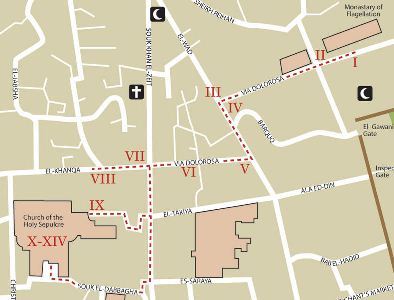

The Via Dolorosa (Latin for “Way of Suffering”) is a historically and spiritually significant processional route in the Old City of Jerusalem. It is traditionally believed to mark the path that Jesus Christ walked on the way to His crucifixion. Spanning approximately 600 meters (2,000 feet), it begins near the site of the former Antonia Fortress and ends at the Church of the Holy Sepulchre, where Jesus is believed to have been crucified, buried, and resurrected.
Location: Old City of Jerusalem, primarily within the Muslim and
Christian Quarters
Length: Approx. 600 meters (0.4 miles)
Stations of the Cross: 14 traditional "Stations" commemorating events on
Jesus’ journey to Calvary
Religious Significance: Central to
Christian pilgrimage and liturgical devotion, especially during Holy
Week and Good Friday
The Via Dolorosa has been a route of Christian pilgrimage since at
least the 4th century, when Christianity became the official religion of
the Roman Empire. The path commemorates the Passion of Christ as
described in the Gospels, and later embellished through Christian
tradition, including apocryphal and devotional texts like the
14th-century Meditations on the Life of Christ.
Over time, the
exact route has shifted, influenced by theological emphasis, urban
development, and control of Jerusalem by different empires. The current
route was formalized by the Franciscan Custody of the Holy Land in the
18th century.
The 14 Stations of the Cross
The Via Dolorosa is
marked by 14 "Stations", each commemorating a moment from Jesus' journey
with the Cross. The first nine are along the street route; the final
five are within the Church of the Holy Sepulchre.
Stations I–IX:
Along the Street
Jesus is Condemned to Death – Near the site of the
Antonia Fortress (inside a Muslim school now).
Jesus Takes Up His
Cross – Adjacent to Station I.
Jesus Falls the First Time – On
El-Wad Road.
Jesus Meets His Mother – Commemorates a traditional
meeting with the Virgin Mary.
Simon of Cyrene Helps Jesus Carry
the Cross – A stone embedded in the wall is believed to mark the spot.
Veronica Wipes Jesus’ Face – Based on later Christian tradition; the
cloth allegedly retained Jesus’ image.
Jesus Falls the Second
Time – At the entrance to the Souq Khan al-Zeit.
Jesus Meets the
Women of Jerusalem – Commemorates Luke 23:28.
Jesus Falls the
Third Time – At the entrance to the courtyard of the Holy Sepulchre.
Stations X–XIV: Inside the Church of the Holy Sepulchre
Jesus is
Stripped of His Garments
Jesus is Nailed to the Cross
Jesus Dies on the Cross
Jesus is Taken Down from the Cross
Jesus is Laid in the Tomb
These events unfold within the
architectural spaces of the Church of the Holy Sepulchre, built on what
early Christians identified as Golgotha (Calvary) and the nearby tomb of
Jesus.
The Via Dolorosa winds through narrow, bustling streets of the Old
City, intersecting with local markets (souks), mosques, churches, and
homes. While the modern route is a devotional path rather than a precise
archaeological line, it is richly steeped in centuries of tradition.
Start Point: Near Lions’ Gate (St. Stephen’s Gate)
End Point:
Inside the Church of the Holy Sepulchre
Languages on Signs:
Latin, Arabic, Hebrew, Greek
Pilgrimages: Catholic, Orthodox, and Protestant pilgrims regularly
walk the route, especially on Fridays and during Holy Week.
Franciscan Procession: Every Friday at 3 p.m., the Franciscan friars
lead a public procession along the Via Dolorosa, stopping at each
Station for prayer, hymns, and Scripture reading.
Ecumenical
Aspect: Though Catholic in its formal structure, the Via Dolorosa is
venerated across all Christian denominations.
While the traditional route is largely symbolic, parts of it overlap
with ancient Roman roads from the 1st century. However:
The exact
location of Pilate’s judgment seat (Praetorium) is debated. Some
scholars place it at Herod’s Palace on the western side of the city, not
at the Antonia Fortress.
Despite uncertainties, the Via Dolorosa
holds spiritual truth and liturgical value more than archaeological
precision.
The Via Dolorosa has inspired:
Artworks: Depictions of the
Stations by artists like Giotto, El Greco, and others.
Music:
Hymns such as Stabat Mater and meditative chants used during Stations
services.
Literature: Referenced in Christian poetry, theology,
and memoirs of pilgrims dating back to Egeria (4th century).